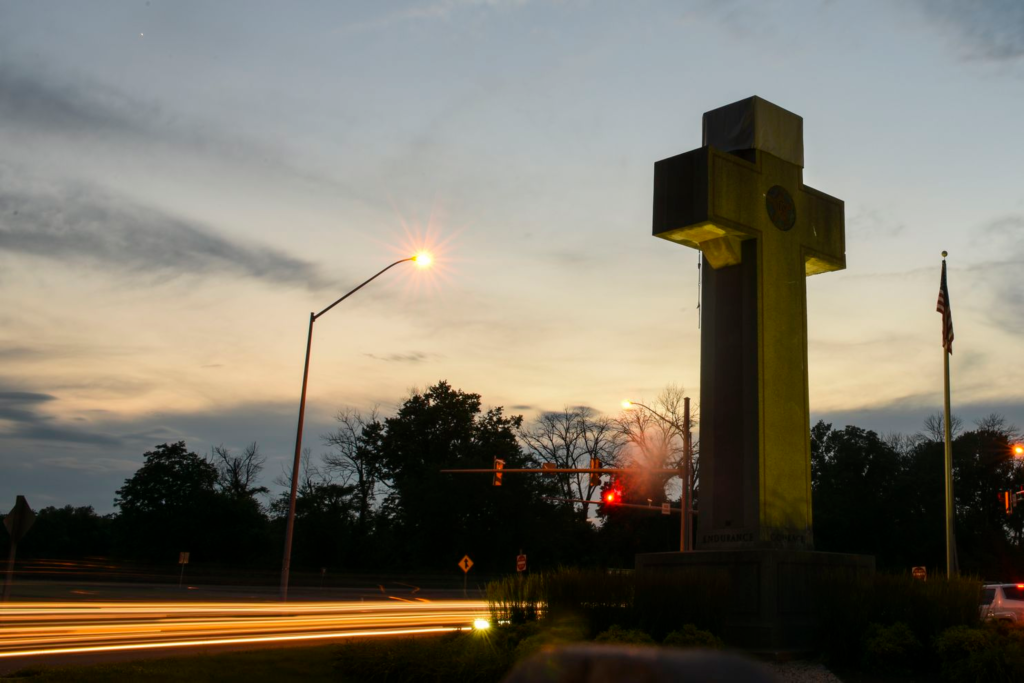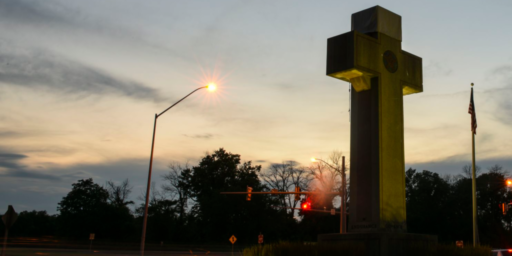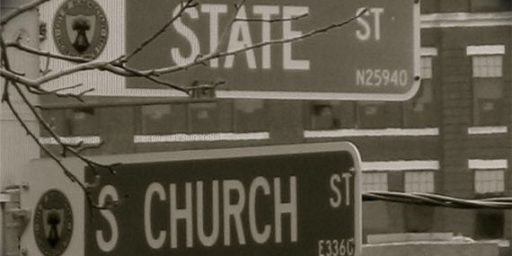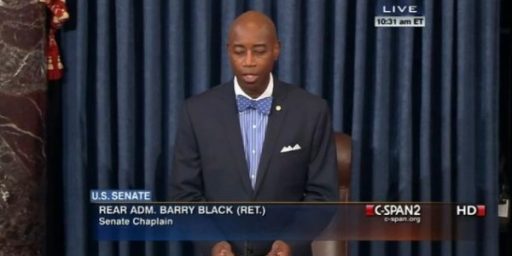Separation Of Church And State Back Before The Supreme Court
The Supreme Court is set to hear oral argument in a case involving a World War I Memorial in the form of a cross on public land in Suburban Maryland.

Tomorrow, the Supreme Court will hear a case involving the separation of church and state and the fate of a 40-foot cross on a public highway in Maryland’s D.C. suburbs:
BLADENSBURG, Md. — In the back room of the Colmar Manor American Legion post, about a mile from a 40-foot cross honoring soldiers who died in World War I, the veterans were worried. They feared the Supreme Court would order the cross to be removed.
“It would be like a slap in the face,” one of the veterans, Stan Shaw, said this month. “These men gave their lives for our country and you can’t build a memorial? If they tear it down, it would be a desecration.”
The cross sits on public land, on a highway median in Bladensburg, Md., in the suburbs of Washington. After dodging heavy traffic to reach it, Fred Edwords, a former official of the American Humanist Association and one of the plaintiffs in the case, explained his objection.
“We have nothing against veterans,” he said. “But this cross sends a message of Christian favoritism and exclusion of all others.
This week, the Supreme Court will hear arguments over the meaning of the Bladensburg World War I Veterans Memorial and whether the cross that is its centerpiece violates the separation of church and state. The case, one of the most closely watched of the term, will give the court an opportunity to clarify its famously confused jurisprudence on government entanglement with religion.
The court’s last encounter with a cross that served as a war memorial was in 2010, and its decision effectively blocking the monument’s removal was badly fractured, with six justices writing opinions.
“A Latin cross is not merely a reaffirmation of Christian beliefs,” Justice Anthony M. Kennedy wrote in a plurality opinion. “It evokes thousands of small crosses in foreign fields marking the graves of Americans who fell in battles, battles whose tragedies are compounded if the fallen are forgotten.”
Justice John Paul Stevens rejected that view. “The cross is not a universal symbol of sacrifice,” he wrote in a dissent. “It is the symbol of one particular sacrifice, and that sacrifice carries deeply significant meaning for those who adhere to the Christian faith.”
The court’s personnel has changed since then. Justices Kennedy and Stevens have retired, and Justice Antonin Scalia died in 2016. But the court is likely to remain divided, much as members of the communities near the Bladensburg cross are.
The memorial was built with private money and completed in 1925. At the dedication ceremony, a member of Congress drew on Christian imagery in his keynote speech. “By the token of this cross, symbolic of Calvary,” he said, “let us keep fresh the memory of our boys who died for a righteous cause.”
A plaque at the base of the memorial, weathered and partly obscured by bushes, lists 49 local men who lost their lives in the Great War, and the pedestal names their attributes: valor, endurance, courage and devotion.
A state commission took over the memorial in 1961, and it has spent more than $100,000 to repair and maintain it. More money is needed, as the cross has suffered water damage and is partly covered by a tarp.
The memorial was in one way ahead of its time, making no distinctions between white and black soldiers.
(…)
In a brief supporting neither side, two prominent law professors — Walter Dellinger of Duke and Martin S. Lederman of Georgetown — proposed a middle ground. In general, they wrote, large Latin crosses on public land run afoul of the First Amendment’s Establishment Clause, which forbids the government from favoring one religious denomination over another.
“To commemorate soldiers of a multitude of faiths with a sectarian symbol — especially one, such as the cross, that represents a promise of redemption to those who have accepted Christ and eternal damnation to those who have not — is to effectively compel nonbelievers to be associated with religious doctrines contrary to their own religious beliefs,” the professors wrote.
But crosses are perfectly appropriate, they continued, on the gravestones provided by the government for fallen Christian service members. “For that reason, the Bladensburg Peace Cross may pass constitutional muster by virtue of an idiosyncratic characteristic of that monument — namely, that it memorializes 49 former residents of Prince George’s County” in Maryland “who were, in all likelihood, all Christians.”
Ian Millhiser at Think Progress calls this case the biggest threat to church-state separation in decades but it strikes me that he is overreacting to a significant degree. While it’s true that the parties defending the Peace Cross do include in their briefs arguments that, if followed by the Court, would lead to large-scale abandonment of decades of precedent on the Establishment Clause. However, it seems unlikely to me that there would be five votes even among the Court’s conservatives to take such a radical approach. This is especially true of Chief Justice Roberts but may also apply to Justices Alito and others who recognize the value and importance of precedent when it comes to issues of fundamental rights such as those protected by the First Amendment. As a result, I suspect that there may be, at most, two or three Justices willing to go along with the radical proposals made by parties defending the cross, especially since it seems clear that there is a far simpler way to reach a result that honors existing precedent.
This case seems to me to be similar to other citations to or acknowledgment of religion in official government actions, most of which have been upheld in the past. The best examples of this can be found in those cases dealing with the issue of prayers opening legislative sessions. This issue first came up a 1983 Supreme Court case called Marsh v. Chambers in which a member of Nebraska’s unicameral state legislature challenged the constitutionality of both the practice of opening each day’s session with a prayer and the fact that the state was paying for the chaplain with taxpayer dollars. The District Court Judge that first heard the case held that an opening prayer did not violate the Constitution, but that state support for the position and the office of chaplain did. On appeal, the Eighth Circuit Court of Appeals ruled that both practices were unconstitutional due to the fact that they violated the Establishment Clause of the First Amendment. In its opinion, the Supreme Court overruled the Eighth Circuit in a 6-3 ruling that relied mostly on the history I make note of above and did not address the constitutional arguments raised by the challengers. Instead, the Court essentially said that, like the practice of putting “In God We Trust” on currency, the practice of having a chaplain deliver prayers at the start of a legislative session, and making that a position paid for out of taxpayer funds, was at best a de minimis violation of the Establishment Clause.
The issue came up again in 2014 in Town of Greece v. Galloway where the Supreme Court dealt with the practice by the town of Greece, New York to open each meeting of its Council with a prayer, a practice that was challenged by a town resident assisted by civil liberties organizations. In a 5-4 ruling, the Court sided with the town and largely follow the precedent set in Marsh. As I noted at the time the court accepted that case, this seems like the ideal ruling in a case like this:
Some government practices that reference religion, I would argue, fall into a de minimis category where it’s recognized that some practices are essentially so harmless that they ought to be permitted as a general rule so long as they don’t become overtly sectarian. One example of that is the whole issue of the inclusion of the words “Under God” in the Pledge of Allegiance, or the appearance of “In God We Trust” on paper currency and coins. As a general rule, there doesn’t seem to me to be anything inherently coercive about either practice. Nobody, including schoolchildren, is legally required to recite the Pledge, and nobody can be legitimately punished for refusing to do so, or for refusing to say “Under God” if they day. Similarly, while we all use coins and paper bills at some point, I doubt anyone pays much attention to what’s written upon them beyond the denomination. Lawsuits challenging both of these practices have been routinely rejected by Federal Courts in no small part because of these facts.
As a general rule, I’d suggest that the idea of opening a legislative session with a prayer falls into this de minimis category in most cases. The prayers that open the House and Senate, for example, are usually fairly general to the point where they can’t be said to be representative of any particular religious tradition beyond, of course, an appeal to a God of some kind. It’s also worth noting, as the Supreme Court did in Marsh, that the practice of opening a legislative session with some kind of prayer has a long history in the United States. Indeed, at one point during the Convention of 1787 when delegates found themselves at an impasse over the drafting of the Constitution, it was Benjamin Franklin, who was, at best, a Deist, who suggested that the body engage in a short prayer. Additionally, the Supreme Court itself opens with the appeal that “God save the United States and this Honorable Court.” Given that history, it seems difficult to argue that those who drafted and ratified the First Amendment intended to ban a practice they themselves engaged in both before and after the Bill of Rights were ratified. Of course, this whole issue becomes arguably problematic when you’re talking about the fact that there are atheists and agnostics in the world, I’m not entirely convinced of the argument that the practice in and of itself is so inherently wrong that it ought to be prohibited for this reason alone. And I say this as someone who considers themselves to be an atheist.
This conclusion seems to be the same in this case dealing with the war memorial. The use of crosses in war memorials is not unprecedented. Indeed, there are military cemeteries around the world filled with row after row of crosses, Stars of David, or grave markers that have an appropriate religious symbol on them depending on the faith of the person buried there. No serious person can contend that this constitutes an endorsement or promotion of a specific religious faith by the government. Similarly, I think that this memorial falls into a similar de minimis category along with legislative prayer and the other issues I’ve mentioned.
This isn’t the first case of its type that the Supreme Court has taken up. In Salazar v. Buono 559 U.S. 700 (2010), the Court dealt with a war memorial called the Mojave Memorial Cross that was erected by the Veterans of Foreign Wars in a National Park in the Mojave desert in 1934. Since the cross was on Federal land, the Plaintiffs in that case, much like the Plaintiffs in this Maryland case, argued that permitting it to stay amounted to an impermissible government endorsement of Christianity in violation of the First Amendment. In a divided opinion, the Justices ended up with a ruling that allowed the cross to stay on Federal property but which also remanded the case to the lower courts for resolution of other issues. To this day, it appears that those issues remain unresolved, but the memorial cross remains standing. Because of the divisions in the court, there was no clear-cut majority opinion even though the majority result allows the cross to remain standing. In a plurality opinion that was joined by Chief Justice Roberts and Justice Alito, though, Justice Kennedy stated that ”A Latin cross is not merely a reaffirmation of Christian beliefs,” he wrote, ”It evokes thousands of small crosses in foreign fields marking the graves of Americans who fell in battles, battles whose tragedies would be compounded if the fallen are forgotten.” Finally, in holding that not every apparent use of religious symbolism by the government or on government property violates the Establishment Clause, Kennedy stated that “The goal of avoiding governmental endorsement [of religion] does not require eradication of all religious symbols in the public realm.” In his dissent, though, Justice John Paul Stevens rejected Kennedy’s take on the issue. Instead, he argued that”[t]he cross is not a universal symbol of sacrifice….It is the symbol of one particular sacrifice, and that sacrifice carries deeply significant meaning for those who adhere to the Christian faith.”
Much has changed on the Supreme Court since the Salazar decision, of course. Justice Stevens has been replaced by Justice Elena Kagan, Justice Scalia has been replaced by Justice Gorsuch and, of course, Justice Kennedy has been replaced by Justice Brett Kavanaugh. This would seem to solidify the conservative wing of the Court, which arguably would mean that the Justices are likely to be sympathetic to the arguments made by the those defending the cross in favor of allowing the cross to remain in place. Until the case has been fully argued, though, it’s hard to guess which way the Court may come down in this matter, My supposition that is that, in the end, the Justices will find, as they have in the case of legislative prayers, that this is a de minimis expression of religion that does not really amount to an endorsement of any particular faith by the government, thus allowing the cross to stay.
Oral argument takes place Wednesday, so we’ll get at least some glimpse at where the Court might stand.




I was raised and baptized a Catholic – until the age of 8, when I told my mother I was an atheist and stopped going to church. I didn’t make the choice lightly, as religion was a very big part of my mother’s life, as well as my grandmother, all my aunts, all my uncles, and cousins. I realized by age 8 it was purely a belief system, and I was already a pragmatist above all else. The whole story of the bible didn’t make sense to me other than a lovely piece of fiction written hundreds or thousands of years ago.
While I don’t mind most religious people – my family among them – it DOES grate me to see giant public crosses anywhere here in the USA other than on Church properties. There should be no “secular” use of crosses to signify ANYTHING other than a church location.
It bothers me the same way a giant Star of David or Star and Crescent moon or a giant Buddah in public places. Such symbols on public land elevate that religion above others. Not cool, bro.
Only someone indoctrinated into the normal-ness of christian dominance could seriously contend that using a symbol exclusive to a single religion could ever be non-religious. Put bluntly, that attitude represents a complete failure to imagine the world from any perspective but own’s own.
Brennan was right:
@EddieInCA:
Wow, that’s precocious. It took me until I was 16.
I mind crosses more than other religious symbols, because 1) Christians often used the cross as a symbol of their dominance over others, and 2) it was, after all, an instrument of rather cruel torture.
Individually, these may be insignificant. But taken together, they form a cultural (and legal?) default assumption of Christianity.
Money, pledge of allegiance, large public crosses everywhere, etc.
The problem I have with this line of reasoning is that it’s always done in isolation, not as one instance of an incredibly common and overwhelming preference for one religion over all others. Taken together, it does feel to me as an endorsement. And then rhetoric that goes with it shows that as well: “God fearing country”, “We are a Christian nation!”, etc.
We became a christian-forward nation, first with Hobby Lobby, and then with the Anti-Gay Cake Baker.
With those decisions Freedom of Religion became bastardized…so it is no longer the freedom to pursue any, or no, religion…but it is now the freedom of so-called christians to impose their religion on everyone else. The appointment of Justice Boof has only cemented this travesty for the next couple of generations.
I find it bizarre that Doug would never ever consider making the analogous argument that ten thousand minor instances of racial or gender preference can be safely dismissed, so long as any one of them isn’t egregious. And yet somehow it’s different for religious preference. It’s a surprising blind spot.
(And yes, all of those arguments from tradition are explicitly arguments to preserve privilege.)
On a different tack, I can’t find any account of this situation that makes it clear whether the original construction was on land that was publicly held at the time. It certainly wasn’t a highway median in 1925… I think it matters. If the state seized the land the memorial was on by eminent domain (to build the highway), or by other purchase, then their duty is to put a historical marker next to the memorial explaining why it was built, and by whom, and when, and how it came to sit in the highway median. If the state commissioned or funded the construction of the monument, then they should have included a more ecumenical mix of symbols — the missing ones are an implicit statement of who is worth remembering and who is not. In that latter case, sell it to a private owner who will move it to private land, or tear it down.
I have a hard time accepting de minimus on a structure that is 40 feet tall. That’s 7 people tall. There isn’t anything minimus about this.
But, I think there is a difference between erecting a monstrosity like this now, and demanding it be torn down. I’d like a Supreme Court ruling that acknowledges that difference — erecting something like it would be an unconstitutional violation of the separation of church and state, but maintaining this old, previously constructed monument may not be.
Otherwise, we are likely to see a whole bunch of 40 foot tall monuments to WW I soldiers dotting the landscape in a few years. Spite crosses. As Jesus would do.
@DrDaveT: Last time we all discussed this cross, it was clear it had been on private land, bought by the state in 1961.
https://www.outsidethebeltway.com/supreme-court-accepts-case-involving-marylands-war-memorial-cross/
Apparently, last time you made the de minimus comment that I made this time….
I may be one of the very few people in this country who was raised without any religion at all–not by proselytizing atheists, but by parents who were simply religiously indifferent. Therefore, I’m always a bit surprised by people who get excited about these matters, from whatever side.
I once asked my sister, if I were to run for the presidency, I could say: “Hey, I have no religion. I have no idea what happens after you die. But I have no objection to anyone else’s beliefs. Whatever floats your boat is fine with me,” and get elected.
Her reply was short and simple: “No.”
@CSK: My family had stopped going to church before I was born, and never bothered having me baptized/christianed/stamped.
At one point, when I wasn’t returning home from college for Christmas, and I said “well, it’s not like we are Christians” I was informed that I was Lutheran. My father also recounted the countless times I was brought to church when we lived in Virginia. I was born sometime after the family left Virginia.
My parents had meant to raise me religious, but just never bothered. Most of my knowledge of Christianity comes from “Jesus Christ Superstar”
@Gustopher:
That’s very interesting. Did you ever find out why they decided to rewrite your history that way? Even at my age, I’m still faintly surprised to encounter intelligent, educated adults who purport to be religious, although I understand that for many people, the regular attendance at a house of worship is far, far less about God than it is about forging financial, political, and social alliances.
@CSK: I don’t think it was rewriting family history as much as they could never remember which child was which and when they stopped doing things. I just slipped through the cracks.
My father was genuinely surprised that I had never been to Church, and now he goes weekly after having let it slide for 30 or 40 years. He made a deal with God that he would go to church every week if his new wife got through her cancer (she wants no part of this deal). For a while, he was going to a Church where the sermons were delivered in some Slavic language, which really is cheating.
I don’t remember my mother caring one way or the other.
Best data I could find quickly shows that from 2007 to 2014:
– Evangelicals declined from 26.3 % of population to 25.4.
– Catholics from 23.9 to 20.8
– Mainline protestants 18.1 to 14.7
– Non-christian faiths grew 4.7 to 5.9
– and unaffiliated grew from 16.1 to 22.8
What we’re looking at here is a rearguard action.
And just to be clear, this isn’t political. Liberals and Democrats aren’t driving this. This is society changing.
@EddieInCA: Agreed, though a giant Buddha would be pretty cool.
@Kathy:
12 -13 for me.
@reid: ask and you shall receive Donghwasa Temple in Daegu, South Korea. I believe that this is one of the World Peace Buddhas.
I was raised religious, as evidenced by my brother, the Reverend Bruce. Became irreligious in my teens as it became clear none of it really made any sense. I describe myself as ignostic, which is to say I’d likely be an atheist if I actually spent any time thinking about it. I’ve generally been tolerant of religion, it seems to help some people get through life. But I find in my old age I’m becoming anti-religious. I’m just tired of watching the fundies screw up politics in this country.
@Gustopher:
Thanks for providing me a prosthetic memory to supplement my increasingly leaky organic one. I am vaguely comforted that I at least fixed on the same key issue of fact this time. If it was built on private land that was obtained by the state, it’s the state’s responsibility to explain it, but it would be wrong to simply eradicate a private memorial.
I know as late as Junior College I was thinking about the ministry. Then I remember laying in bed one night thinking about how it was all based on scripture that was so ancient that there was no possibility that any of it could be verified.
It was right at the time that this song hit the airwaves.
I haven’t been the same since.
encore